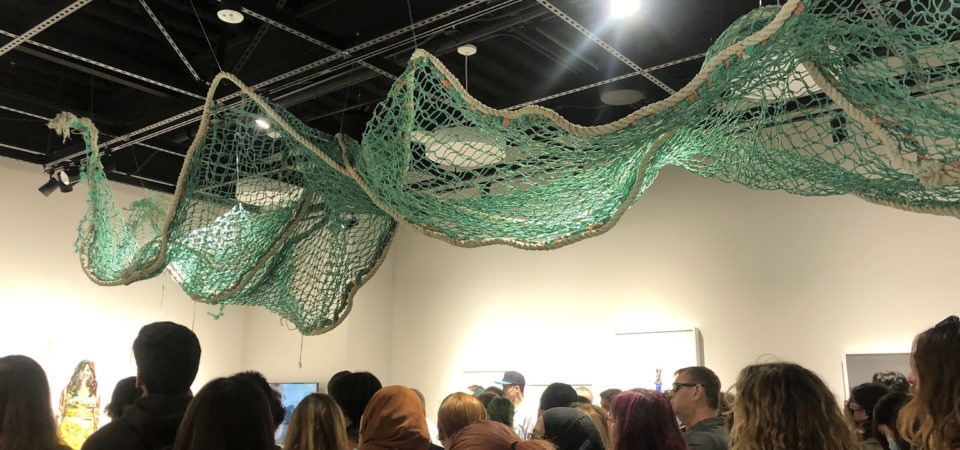Great Wave
Exhibition Dates: Sept 19, 2022 – Jan 13, 2023
Edward M. Dowd Art and Art History Building, Santa Clara University
‘Artists through the ages have looked to the ocean in all its majesty for clues about the planet’s future. This group exhibition features contemporary artists who live near the coast, and whose work immerses us in a watery drama. Organized by longtime Bay Area curator Ann Trinca, this show finds inspiration in the work of Japanese ukiyo-e master Katsushika Hokusai’s ubiquitous woodblock print The Great Wave. The Great Wave is recognizable across cultures as a symbol of the unpredictable power of the ocean. Using this historic piece as a jumping-off point, the artists in the exhibition explore the ocean as a source of mystery and resilience.”
— Curator Ann Trinca
Artists: Brandon Anderton, Tess Felix, Peter Hassen, Liz Hickok, Kenyatta A.C. Hinkle, Hughen/Starkweather, Luc Janssens, Josh Keyes, Laura Arminda Kingsley, Richard Lang and Judith Selby Lang, Courtney Mattison, Allison Watkins and Angela Willetts
Remnant
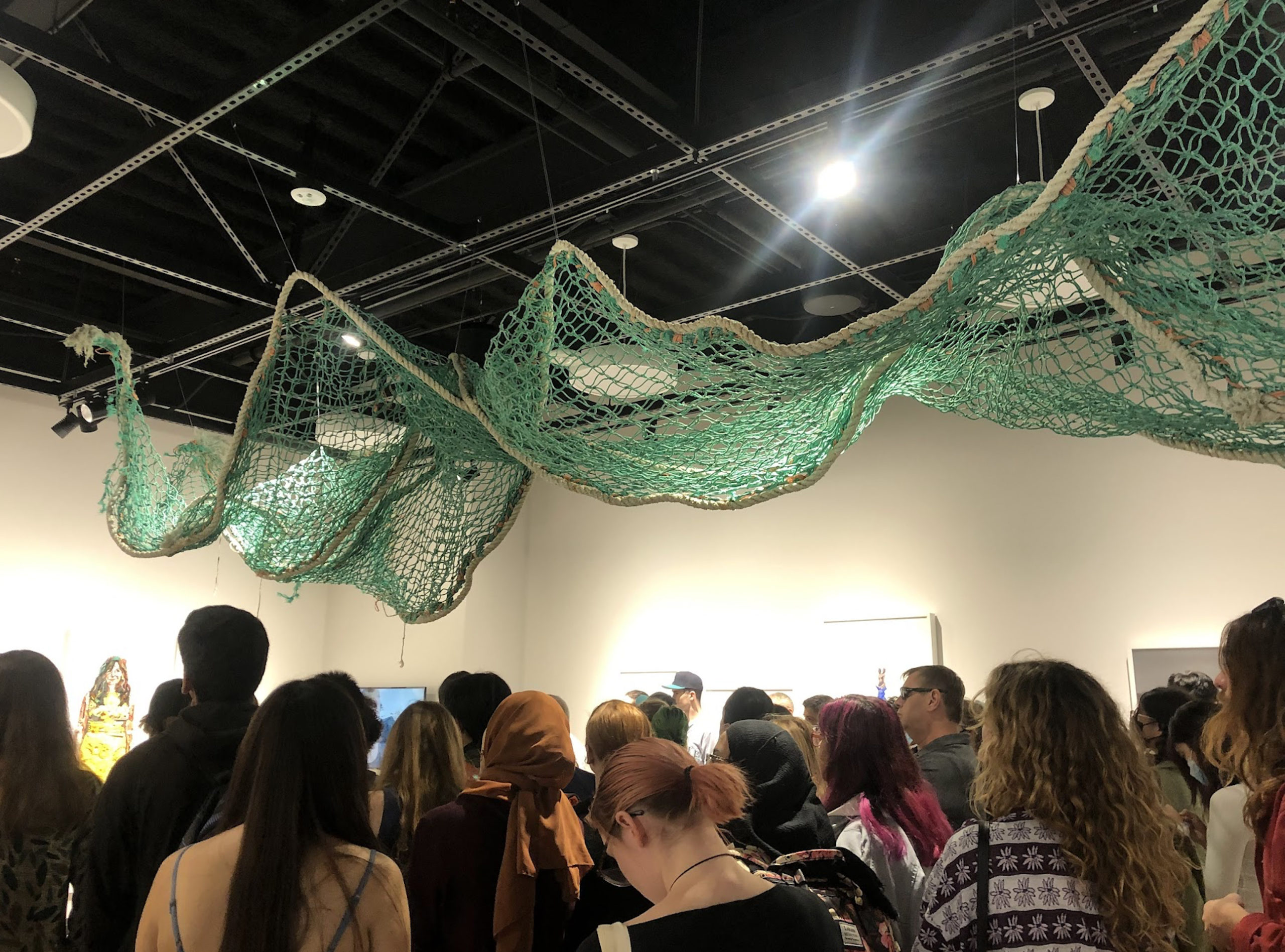
As a powerful presence, Remnant reminds us of the problem of commercial overfishing, by-catch, and whale entanglement. Buffeted by wind and surf, much of its beauty is the result of natural forces, plus there is the mystique of its odyssey from ocean to beach. Intrigued with what unbearable beauty we might find in this mess of netting; inspired by jazz and the rhythm of poetry, we present this undulating form as a site for contemplation.
When one thinks about the journey this massive net has been on — lost from a fishing trawler in the Pacific Ocean, washed ashore on to Kehoe Beach in the Point Reyes National Seashore, then to the gallery here at Santa Clara University to see this “mess” presented in a formal setting gives one pause.
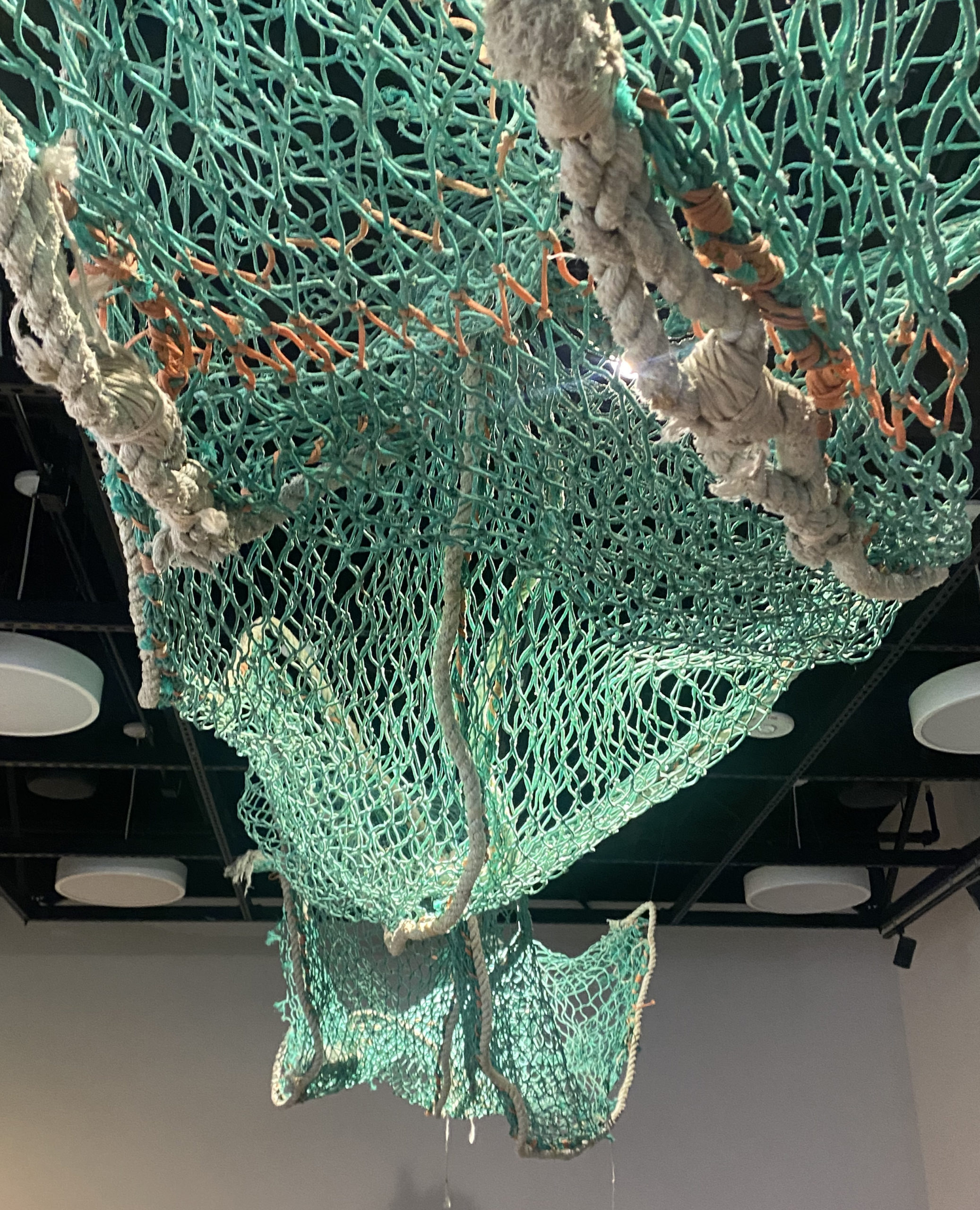
When you think of fishing, you might harken back to a pole, a hook, with a worm dropped in a stream. Fond memories of catching and eating or catching and releasing. When you think of commercial fishing, you probably think of giant nets swooping up a school of fish. You’re not wrong! Over 80% of fish are caught via nets. Industrial fishing nets with lengths up to 7 miles, catch and kill unintended species— bycatch fish, sea birds, turtles, and whales—en masse. In addition to removing large numbers of fish, many large-scale fishing practices also destroy aquatic habitats by dredging or seafloor trawling that scoops up everything that will be used along with much that will be discarded. This is extraction on a monumental scale. Fishing gear can be even more destructive when it becomes lost or forgotten in the water because it continues to “ghost fish” ensnaring animals that aren’t being harvested for use.
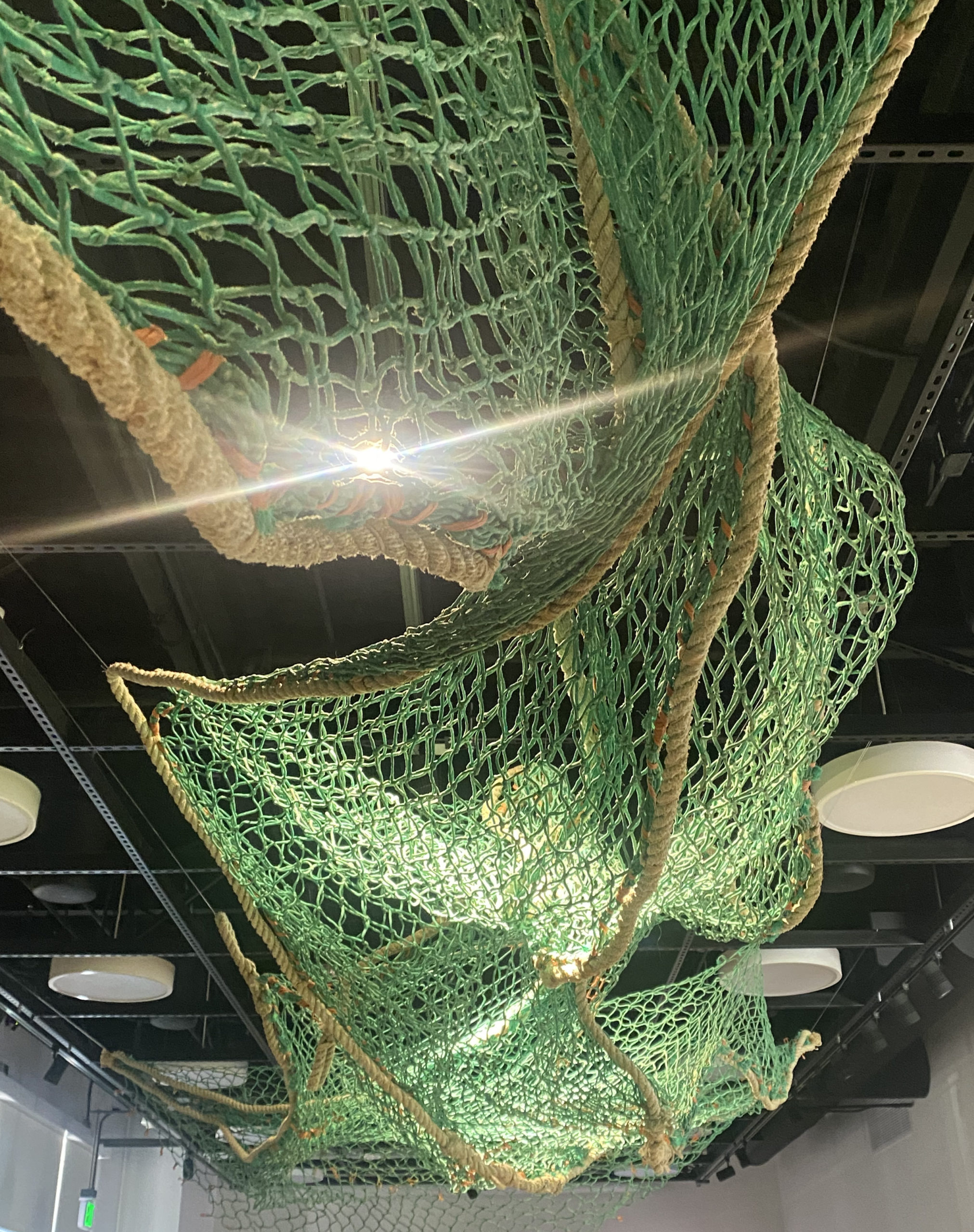
These snarls, AKA “Ghost Nets”, are pernicious entanglements of lost commercial fishing rope and monofilaments. Birds, fish, and marine mammals get caught in this silent floating debris —trapped in what is called “ghost fishing.”
Since 1999, as a collaborative team, we have collected plastic from just 1,000 yards of Kehoe Beach. Along the way, we have gathered huge quantities of ropes and netting. Most people don’t know about ghost nets. They have never seen one because most are lost at sea. But they do wash ashore and over the years, we have amassed quite a pile of “inventory” in our barn and barnyard. Many thanks to our colleague and friend, beachcomber Richard James, for retrieving this remnant of a trawl net from the beach.
About Plastics
We have mined the fossil hydrocarbons for heating our homes and workplaces, for driving our planes and trains and automobiles, and yet we only vaguely understand that at least 20% of these irreplaceable primordial remnants laid down millions of years ago in Carboniferous fern bogs to make coal and in planktonic sediment to make oil and gas, are being used to make plastic that gets blithely tossed away. Tossed away in such quantity that today in the North Pacific Gyre, there is a raft of floating plastic the size of Texas, some even say Brazil. We toss it away, blind to the implications.
What we do know is that if we fail in our attempts to stop this mad rush to use it all up, industrialized, information-driven civilization will never rise again. The Bronze Age was founded on metal easily mined with minimal effort, picked up off the ground, in fact. The Petroleum Age jump-started with plentiful oil seeping out of the ground. Oil production has reached its peak and though we still have half the amount we started with; it is only reachable by powerful infrastructure driven by oil. In other words, every drop of oil we extract now is twice as hard to get as it was 10 years ago and it will be twice as hard as those ten years from now. In other words, if we blow it this time, there will be no second chance. An industrial civilization will never again rise from “scratch.”
When the common use of plastic found its way into our lives during WWII, plastic was touted as an exciting new material that would revolutionize, and indeed, it has — providing new hips and knees, allowing for unbelievable medical advances. But we’ve been inundated with “convenience” and a throw-away ethos. In the swirl of debris, from food shopping to consumer goods, plastic is the unseen background of daily living.
Besides the blight of plastic, a mad scientist’s brew of toxic chemicals is leaching into our bodies. We have learned that every human has traces of plastic polymers in their bloodstream. That’s the bad news we live with these days.
Plus, with the advent of electric vehicles and solar power installations, oil companies fear the reduction of consumption, so they are looking for ways to continue their revenue streams, and that one word is PLASTIC.
In a recent report on KALW, it was brought to our attention that a huge facility for making plastic, the largest ever, has opened in Texas.
From KALW
“In this Series, we discuss a major petrochemical venture between chemical giant Saudi Basic Industries Corporation and Exxon Mobil. Last year, they created a joint venture called the Gulf Coast Growth Ventures manufacturing facility in San Patricio County, Texas.
The complex produces materials used in packaging, agriculture, films, construction materials, clothing, and automotive coolants. The plant is reported to be the largest ethane steam cracker in the world. What are the environmental and health risks for the communities living near these plants?”
SO, time and tide…wait for no one.
This old proverb is usually interpreted to mean that the course of neither time nor the seas’ tides can be halted or delayed, so you’d better get on with what you’re supposed to do.
We know all too well the truth of that proverb and especially lately, as it seems that not only are we getting older, faster because it seems that time itself is going ever faster. As we gaze out at the eternal waves and the ever-fluctuating tide line, we renew our vows to Kehoe Beach — our one place on the planet.
We tell everyone that you don’t have to do everything. You just have to do something. Our one thing is tending 1000 yards of one beach. Just two people, one beach.
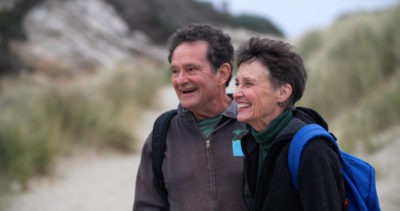 Since 1999 Richard Lang and Judith Selby Lang, as a collaborative team, have been visiting Kehoe Beach, Point Reyes National Seashore in Northern California. They have rambled 1000 meters of tideline of this one beach hundreds of times to gather plastic debris washing out of the Pacific Ocean, and from this one beach, have collected over two tons of material. By carefully collecting and “curating” the bits of plastic, they fashion it into works of art that matter-of-factly show, with minimal artifice, the material as it is. The viewer is often surprised that this colorful stuff is the thermoplastic junk of our throwaway culture.
Since 1999 Richard Lang and Judith Selby Lang, as a collaborative team, have been visiting Kehoe Beach, Point Reyes National Seashore in Northern California. They have rambled 1000 meters of tideline of this one beach hundreds of times to gather plastic debris washing out of the Pacific Ocean, and from this one beach, have collected over two tons of material. By carefully collecting and “curating” the bits of plastic, they fashion it into works of art that matter-of-factly show, with minimal artifice, the material as it is. The viewer is often surprised that this colorful stuff is the thermoplastic junk of our throwaway culture.
This article is part of the MAHB Arts Community‘s “More About the Arts and the Anthropocene”. If you are an artist interested in sharing your thoughts and artwork, as it relates to the topic, please send a message to Michele Guieu, Eco-Artist and MAHB Arts Director: michele@mahbonline.org.
Thank you. ~

